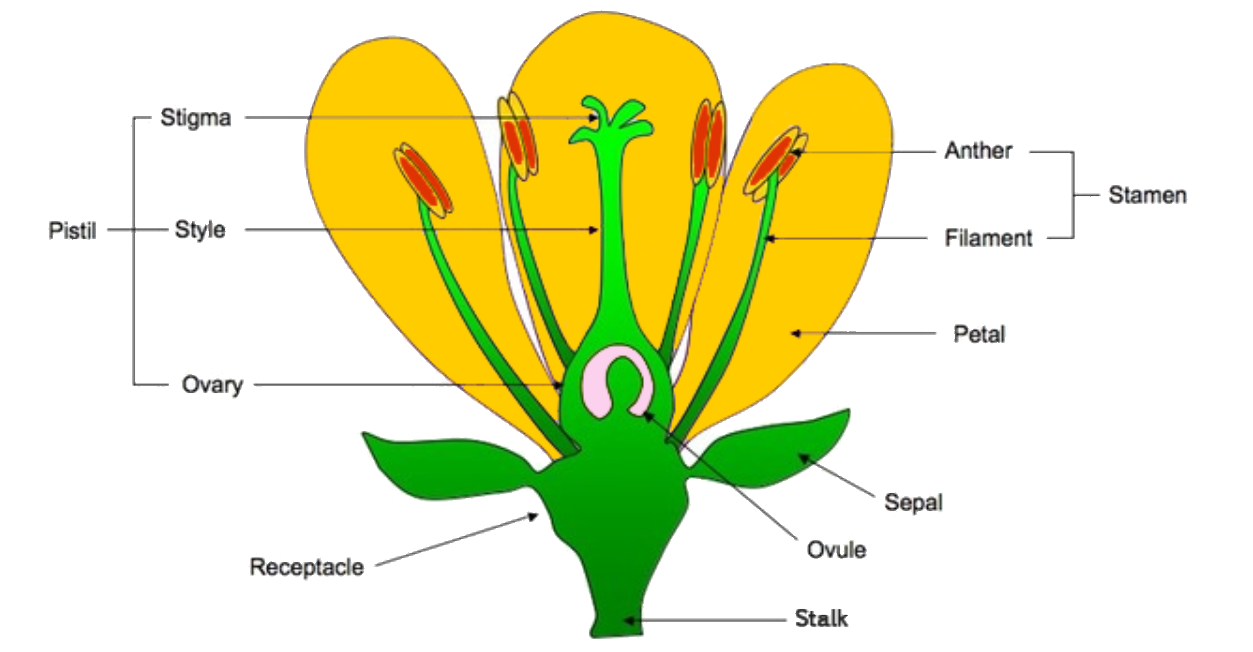
Sketch the reproductive parts of a flower.
Answer
428.6k+ views
Hint: Plant reproduction is a process of production of new off-springs in the plants. The reproduction process in plants occurs in two types which are sexual and asexual reproduction. Sexual reproduction is performed with the help of flowers present in the plants whereas asexual reproduction from single parent without any fusion of gametes.
Complete answer:

Sexual reproduction involves the fusion of male and female gametes of the plant and through the process of meiosis, rearrangement of genes occurs. Another filament are the male parts of the plant collectively known as stamen whereas stigma, style and ovary are the female parts of the plants collectively known as pistil. The fusion of male and female gametes produces a diploid zygote which helps in acquiring characters from both male and female plants into the new offspring which develops a mitotic cell division into a multicellular sporophyte.
Anthers are the pollen containing units present in the stamen of the male reproductive part of the plant. They contain pollen that is transferred to the female reproductive part by the process called pollination. Filament is a stalk on top of which the anthers are present. It helps to give support to others and helps them to attain required height for the pollination process.
Stigma modifies the part of the pistil which receives pollen from the male part. Style is the long cylindrical part of female flower that helps to connect stigma with the ovary so that the pollen trapped by the stigma enters into ovary.Ovary is the female reproductive part in which the mating of male and female gamete occurs and zygote is formed and developed.
Note: There are other parts of the flower that are petal and sepal which are used to attract pollinating agents like insects and birds as petal contains nectar and sepal is hard covering that protects the flower.
Complete answer:

Sexual reproduction involves the fusion of male and female gametes of the plant and through the process of meiosis, rearrangement of genes occurs. Another filament are the male parts of the plant collectively known as stamen whereas stigma, style and ovary are the female parts of the plants collectively known as pistil. The fusion of male and female gametes produces a diploid zygote which helps in acquiring characters from both male and female plants into the new offspring which develops a mitotic cell division into a multicellular sporophyte.
Anthers are the pollen containing units present in the stamen of the male reproductive part of the plant. They contain pollen that is transferred to the female reproductive part by the process called pollination. Filament is a stalk on top of which the anthers are present. It helps to give support to others and helps them to attain required height for the pollination process.
Stigma modifies the part of the pistil which receives pollen from the male part. Style is the long cylindrical part of female flower that helps to connect stigma with the ovary so that the pollen trapped by the stigma enters into ovary.Ovary is the female reproductive part in which the mating of male and female gamete occurs and zygote is formed and developed.
Note: There are other parts of the flower that are petal and sepal which are used to attract pollinating agents like insects and birds as petal contains nectar and sepal is hard covering that protects the flower.
Recently Updated Pages
The correct geometry and hybridization for XeF4 are class 11 chemistry CBSE

Water softening by Clarks process uses ACalcium bicarbonate class 11 chemistry CBSE

With reference to graphite and diamond which of the class 11 chemistry CBSE

A certain household has consumed 250 units of energy class 11 physics CBSE

The lightest metal known is A beryllium B lithium C class 11 chemistry CBSE

What is the formula mass of the iodine molecule class 11 chemistry CBSE

Trending doubts
State the laws of reflection of light

One Metric ton is equal to kg A 10000 B 1000 C 100 class 11 physics CBSE

Difference Between Prokaryotic Cells and Eukaryotic Cells

How do I convert ms to kmh Give an example class 11 physics CBSE

Describe the effects of the Second World War class 11 social science CBSE

Which of the following methods is suitable for preventing class 11 chemistry CBSE




